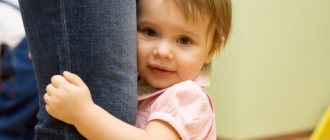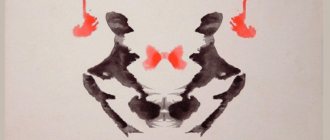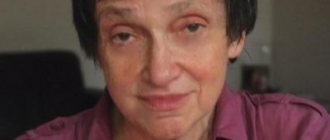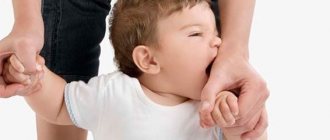The essence of the adaptation process for first-graders
School poses a large number of new tasks for the child, which require the mobilization of his physical and intellectual strength.
A first-grader needs to get used to the new conditions that have arisen in his life and adapt to them. We are talking about adaptation to school - the most stressful period in the first year of study. It occurs at the social, physiological and psychological level. The adaptation period for each child occurs individually. Its duration can range from three weeks to six months. It is important to monitor the dynamics of the adaptation process, identify the causes of emerging maladjustment and carry out the necessary correction of identified deviations in the course of “adjusting” a first-grader to school life.
| Factors of social adaptation | Factors of physiological adaptation | Factors of psychological adaptation |
|
|
|
Diagnostic criteria for ADHD according to the DSM-IV classification of disorders (1994)
To make a diagnosis, at least 6 of the following symptoms of inattention, hyperactivity and impulsivity must be present, which have persisted for at least 6 months and are severe enough to indicate insufficient adaptation and failure to meet normal age characteristics.
Table 1
Distribution of surveyed primary school students
| Duration of schooling, years | Age, years | Number of people examined | ||
| boys | girls | Total | ||
| 1 | 7 | 107 | 91 | 198 |
| 2 | 8 | 93 | 73 | 166 |
| 3-4 | 9-10 | 100 | 73 | 173 |
| Total: | 300 | 237 | 537 | |
Basic diagnostic issues
Diagnosing the adaptation of first-graders involves conducting an in-depth individual examination. It is aimed at obtaining information about the qualitative indicators of the main necessary changes that must occur in all areas of the child’s life and activity.
The main goal of diagnosis is to identify children who have difficulty adapting and need professional help. Based on the results of the study, individual development trajectories of schoolchildren should be determined and recommendations should be developed for teachers and parents to support children in the process of their school adaptation.
Diagnostics are initiated by the school administration in order to obtain general information about the level of adaptation of all first-graders. This type of activity must be recorded in the school’s work plan for the academic year. The school psychologist is directly involved in conducting research and processing data in close collaboration with the class teacher of first-graders.
Diagnostics is carried out in several stages.
- Observation - takes place during the first month of school to detect peculiarities in the child’s behavior during lessons and breaks.
- The survey is carried out from September 15 to 30. Aimed at establishing:
- the level of mental development of first-graders, identifying children who are lagging behind the age norm;
- the degree of formation of motives for learning, identification of the leading motive;
- stability of the student’s emotional state, the presence of negative or positive emotions that the child experiences in different educational situations;
- level of school anxiety, analysis of factors that cause discomfort, tension, and fear in a first-grader.
- Drawing up individual conclusions - after the survey, final processing of the data obtained is carried out, on the basis of which:
- children at risk are identified;
- recommendations are developed for teachers and parents.
The basis for drawing up such a conclusion should be a summary table with diagnostic results. It may look like this.
- Familiarization of participants in the educational process with the results of diagnostics of adaptation of first-graders - the final conclusions are discussed during:
- small teachers' council or consultation (most often they are held during the autumn holidays);
- individual consultations;
- parent meeting.
- The development of individual programs for working with children with signs of maladjustment occurs in close cooperation with all interested parties. This work must be completed by the end of the first quarter. The program must include:
- group classes;
- individual psychological and pedagogical support;
- individual forms of work aimed at solving specific problems.
You can use these recommendations from R.V. Ovcharova.
- Implementation of individual programs takes 1–4 months.
- Repeated diagnostics should be carried out at the end of the school year (April - May) to obtain final data.
- The final stage is necessary to compare the starting and final indicators. At this stage, the dynamics of the child’s development are analyzed and the effectiveness of the implementation of the recommendations and programs developed is established.
Based on the information provided, the psychologist must draw up a plan for diagnosing the level of adaptation of first-graders, specifying the indicated areas of activity. It may have this form:
| Kind of activity | Goal and tasks | The content of the work | Information summary form | Responsible | Deadlines |
To obtain complete and reliable information about each child during the diagnostic process, it is also necessary to carry out:
- parent survey;
- interviewing teachers;
- study of children's medical records.
The main direction of diagnostic activity is conducting surveys and testing of first-graders using various techniques. It can be carried out both individually and in group form. Typically, it takes 15–20 minutes to examine one child.
Observation
The most common diagnostic method is observation. The most commonly used method is sample observation. During its implementation, only those features of the child’s behavior are recorded that distinguish him from the general mass of first-graders. Observation is carried out simultaneously for all children in the class. Basic requirements for organizing surveillance:
- presence of an observation scheme;
- systematic;
- objectivity.
Observation should also include:
- analysis of the child’s progress;
- viewing notebooks;
- listening to oral responses;
- analysis of existing interpersonal relationships.
As a result of observations, the main seven components are assessed (on a 5-point scale):
- educational activity;
- mastering program materials;
- behavior in lessons;
- behavior during breaks;
- relationships with classmates;
- relationship with the teacher;
- emotions.
The corresponding scores and conclusions must be entered into the school adaptation card.
The total points can be interpreted as follows:
- 35 – 28 – high level of adaptation;
- 27 – 21 – average;
- 20 or less is low.
To conduct observations during the adaptation period, you can use Stott's map , which provides for the study of asociality, infantility, subordination, activity and uncertainty.
Factor Asociality, Infantility, Subordination, Activity, Uncertainty - see here.
With this method, the overall score is not displayed, but each criterion is assessed separately. After this, groups of children with the highest (above 65%) scores for each factor are determined.
Material and methods
The causes of SD were studied through a neurological and neuropsychological examination of 537 students (300 boys and 237 girls) of 3 Moscow mass secondary schools aged 7 to 10 years, who studied in grades 1 to 5 (Table 1). The survey covered entire individual classes. During the neurological examination, conversations were conducted with the child and his parents, and data from outpatient records were assessed. Attention was paid to the presence of pathology during pregnancy and childbirth in the child’s mother, the nature of his early psychomotor development, and information about the diseases he suffered. Then a general examination was performed with a detailed examination of the neurological status.
During a neuropsychological examination, the children were assessed for their general level of intellectual development and the degree of formation of higher mental functions: gnosis, praxis, speech, memory, thinking. The neuropsychological study was based on the method of A. R. Luria [9, 10], adapted for childhood.
As an algorithm for diagnosing various types of minimal brain dysfunction (MCD), we used criteria developed by the American Psychiatric Association and published in the DSM-IV classification of psychiatric disorders [13].
Test "Houses"
Another method for diagnosing first-graders’ adaptation to school is the “Houses” test. It is carried out to determine:
- value orientations;
- social emotions;
- personal relationships.
This test is a color association study. The author of the test is O.A. Orekhova. To carry it out you need to prepare:
- questionnaire;
- 8 pencils (black, grey, brown, purple, blue, green, yellow, red).
Pencils should not look different from each other.
For the study, you need to invite a group of children (10-15 people) and seat them separately from each other. It is imperative that the teacher is not present in the classroom during the diagnosis. Children must complete three tasks.
Exercise 1.
There is a picture of a house, to which a path of 8 rectangles leads. First graders are asked to color them in order, and each color can only be used once. First you need to choose the color you like best and decorate the first rectangle. Next, take the color that you like best among the remaining ones. The last rectangle will be painted with the ugliest color, in the child’s opinion.
Task 2.
Children will color a picture that shows a street with several houses. The psychologist should explain that different feelings live in these houses and children need to choose for each of them the color with which they are associated when naming such words: happiness, grief, justice, resentment, friendship, quarrel, kindness, anger, boredom, admiration .
In this task, the same color can be used several times. If schoolchildren do not understand the meaning of any of the named words, then the psychologist explains it.
Task 3.
The picture used is the same as in the previous task. Now the children must decorate the houses in a color that symbolizes their inhabitants. The soul of a child lives in the first house. The inhabitants of houses 2-9 are responsible for his mood in such situations:
- when he goes to school;
- in a reading lesson;
- in a writing lesson;
- in a math lesson;
- when communicating with the teacher;
- when communicating with classmates;
- when he is at home;
- when doing homework.
In the tenth house, the child must himself accommodate any “colored” tenant, who will signify his special condition in a situation that is important to him personally. After completing this task, each first grader must tell the psychologist what exactly this tenth house means to him (it is better to do this so that the other children do not hear), and he makes a corresponding note on the questionnaire.
When summing up the results of this diagnosis of adaptation of first-graders, the psychologist should focus on the following numbering of colors: 1 - blue, 2 - green, 3 - red, 4 - yellow, 5 - purple, 6 - brown, 7 - black, 0 - gray.
To avoid having to do such complex calculations yourself, you can try to find a special program on the Internet designed to process the results of this test.
Inattention
1. The child is often able to maintain attention to details; due to negligence and frivolity, he makes mistakes in school assignments, work and other activities.
2. Usually has difficulty maintaining attention when completing tasks or playing games.
3. Often one gets the impression that the child does not listen to speech addressed to him.
4. Often the child is unable to adhere to the proposed instructions and fully cope with lessons, homework or duties at the workplace (which has nothing to do with negative or defiant behavior, or an inability to understand the task).
5. Often has difficulty organizing independent completion of tasks and other activities.
6. When required to perform tasks that require long-term mental stress (for example, school assignments, homework), he usually avoids it, expresses dissatisfaction, or resists it.
7. Often loses things needed at school and at home (for example, school supplies, pencils, books, work tools).
8. Easily distracted by constant stimuli.
9. Is often forgetful in everyday situations.
Questionnaire “Level of School Motivation”
To determine the level of adaptation of first-graders to school, you can also use diagnostics of the child’s motivational sphere according to N.G. Luskanova . It is conducted in the form of a short questionnaire, the questions of which are read aloud, and children must choose the appropriate answer.
Read more.
When processing the results, all answers must be entered into a table that contains a special key for determining the number of points received.
The calculation results should be interpreted as follows.
This technique allows not only to identify the level of adaptation of schoolchildren, but also to identify the reasons leading to a decrease in the child’s motivation to attend school.
“Ladder” technique
To determine the level of self-esteem of a child when diagnosing the adaptation of first-graders to school, it is recommended to use the “Ladder” technique. To carry it out, you need to prepare a drawing of a staircase with numbered steps.
The child is invited to familiarize himself with this arrangement of schoolchildren on the steps:
- 1 - the nicest guys;
- 2 and 3 - good;
- on 4 - neither good nor bad;
- 5 and 6 - bad;
- at 7 - the worst.
The first grader must indicate the step on which, in his opinion, he himself should be. You can draw a circle on this step or put another mark. There is no need to focus on the numbering of steps when conducting the test. It is desirable that the same ladder be drawn on the board, and the psychologist would simply point to each step and explain its meaning, and the children would simply correlate it with their image.
The results are assessed as follows:
- 1 - inflated self-esteem;
- 2 and 3 - adequate;
- 4 - underestimated;
- 5 and 6 - bad;
- 7 - sharply underestimated.
This technique can be replaced with a similar test “Mugs” .
Also, to determine the level of self-esteem of a first-grader, you can use the method of studying adaptation the Luscher method , which is carried out using special forms.
Impulsiveness
1. Often answers questions without thinking, without listening to them completely.
2. Usually has difficulty waiting his turn in various situations.
3. Often interferes with others, pesters others (for example, interferes in conversations or games).
Some symptoms of impulsivity, hyperactivity and inattention begin to cause concern when a child reaches 7 years of age.
Problems caused by the symptoms listed above occur in two or more environments (for example, school and home).
There is strong evidence of clinically significant impairments in social interactions or school learning.
According to the DSM-IV classification, in cases of complete compliance with the clinical picture observed over the last 6 months simultaneously with all the listed criteria for all signs, a diagnosis of a combined form of ADHD is made.
If over the past 6 months there has been complete compliance of symptoms with the criteria for the “Inattention” trait, with partial compliance with the criteria for the “Hyperactivity” and “Impulsivity” traits, the diagnostic formulation of ADHD with predominant attention disorders is used.
If over the past 6 months there has been complete compliance of symptoms with the criteria for the signs “Hyperactivity” and “Impulsivity” with partial compliance with the criteria for the trait “Inattention”, then the diagnosis states: ADHD with a predominance of hyperactivity and impulsivity.
If there were appropriate indications, children with detected pathology were sent for additional consultations (pediatrician, ophthalmologist, otolaryngologist, family psychologist, psychiatrist) and studies (EEG, electroneuromyography, CT).
Anxiety test
To determine the level of anxiety in a first-grader, it is proposed to conduct a survey of teachers and parents, more details.
When summing up the results, it is necessary to calculate the total score, which sums up the results of both surveys.
a “Good-Bad Chart” test to determine a child’s emotional problems
There is another projective method for diagnosing school anxiety that is similar in its direction (A.M. Prikhozhan).
Correction
A popular mistake in working to correct maladjustment is fighting the symptoms that have appeared. For example, a child asserts himself through fights. It is useless to punish him for fighting and prohibit him from doing so. Even if he stops fighting, he will do something else, for example, vandalism, since the need for self-affirmation will remain, and the child still does not know the correct methods. Accordingly, the goal of the work is to help the child assert himself in a socially acceptable way.
So what can you do:
- Identify the child’s abilities and interests.
- Identify problems that accompany the need for self-affirmation, for example, uncertainty or fears.
- Help the child overcome problems and do useful and interesting things, for example, join a club, take up drawing or sports, play KVN, and so on.
Using the same principle, you need to work with a child’s aggression and rudeness. Perhaps this is an overcompensation for self-doubt and inability to communicate. Accordingly, we teach how to communicate and be confident - rudeness goes away on its own.
Correction of maladjustment requires an individual approach, which takes into account:
- age characteristics;
- individual personal characteristics;
- manifestations and root causes of maladjustment;
- development environment conditions.
There is no need to be afraid of maladaptation, much less to hush up the problem. Problems in adaptation occur in 15-40% of schoolchildren. Unfortunately, this is a popular problem, but in the early stages it can be easily corrected.
The work should be carried out jointly by parents and school specialists:
- the psychologist draws up recommendations and an individual development plan for the child;
- parents monitor compliance with recommendations within the home (assistance in mastering knowledge, control over the completion of lessons, analysis of missed or incomprehensible material);
- The teacher helps the child in the classroom: creates situations of success, monitors the healthy psychological climate and adherence to an individual-personal approach.
An important role in correcting a child’s maladaptation is played by the individual personal qualities of adults (parents and teachers) and the nature of their interaction. It is important to remember the overall goal - to help the child adapt. The unity of parents and teachers helps to at least reduce the level of anxiety in the child.
Junior schoolchildren
Primary school students are just beginning to move from gaming to educational activities, so games are an excellent form of assistance in adaptation:
- If we are talking about problems in relationships with the team, then games for unity.
- For the development of cognitive processes - intellectual games.
Unity games:
- Orchestra. The game is played by analogy with real conducting: the presenter (conductor) raises and lowers his hands. The higher he raises them, the louder the other children (orchestra) perform the chosen action.
- “Let the one who...” The leader goes to the center of the circle and says, “Let the one who likes to play football (for example) come out to me.” You can name any word: an item of clothing, a hobby, external features.
Educational games should be selected depending on the area in which the gap is noted. Here are some examples:
- For the development of short-term memory. The child is asked to look for 20 seconds at a sheet with drawn figures, remember them and then repeat them on a blank sheet of paper.
- Associations. The child is asked to connect pictures and words according to their meaning, and then give reasons for their decision.
- The “Complete the picture” technique will allow you to determine your creative potential. The child is offered a set of identical (simple level) or different (difficult level) blank figures and is required to complete them. There are no other restrictions. Not only the result of the work is assessed, but also activity, variability, speed of thoughts and actions.
Teenagers
The best method for correcting maladaptation in a teenager is to help him achieve self-realization. To do this, you need to have conversations, organize joint and interesting activities for the teenager, respect his personality and sense of adulthood.
Creativity therapy has proven itself positively. The type of occupation is selected individually. For example, if the problem is not only socio-psychological (uncertainty), but also in the cognitive sphere, then activities that require concentration and develop fine motor skills (sewing, embroidery, weaving) are suitable.
In order to unite the class, it is necessary to use trainings and group consultations. Work should be aimed at developing empathy, reflection, independence (including self-organization).
For example, you can follow this training plan:
- Warm-up and introduction (half an hour). Children get to know each other by playing “Hot Ball”: they throw a ball to each other, say their name and give a compliment to the other person (to whom they throw). Then the leader assesses the readiness of the entire group, the activity of individual participants, and the characteristics of the group’s composition. The game “Arrow” will help with this: the group needs to imagine that they are an arrow (scale), and move towards the maximum or minimum as much as they are ready to work, cheerful, healthy, and so on. Well, in conclusion, the presenter names the topic of the training, voices the problem and describes the essence and goals of the lesson.
- Main part. Depending on the specific conditions, relaxation with the release of the subconscious and imagination, situational role-playing games, simulation games, psychological studies, psychodrama, discussions, metaphors, drawing, and so on are used.
- Reflection. The results of the training are summed up, plans are made for the next lesson (7-8 lessons in total), the thoughts and feelings of the participants are discussed.
Conducting the training is permissible only by a specialist! This method has its own technology and a number of nuances.
General recommendations
Regardless of the child’s age, it is the responsibility of parents, psychologists and teachers to:
- Cooperate with the child, pay more attention, play, advise, observe.
- Preparing a child for school: working on the development of all types of thinking, developing fine motor skills, working on voluntary attention.
- Avoid high expectations and demands, allow the child to be imperfect and make mistakes. Sincerely notice successes without ridicule.
- Do not compare your child with other students, especially more successful ones. A child's success can only be assessed in relation to his previous successes.
- Help the child find a reference group and activities for self-realization. Additional education that matches the interests and capabilities of the child will give self-confidence due to the attention, success, and emotional support that the child will receive in this area. Gradually, self-confidence will spread to all areas of life.
- Make important the area in which the child has better success. Gradually, the attitude “If I am so good here, then I can succeed in another matter” will form.
It must be remembered that any word from an adult has educational power and corrects the behavior and thinking of the student. Both praise and scolding, shouting are tools of reinforcement and provocation to one or another response behavior.










